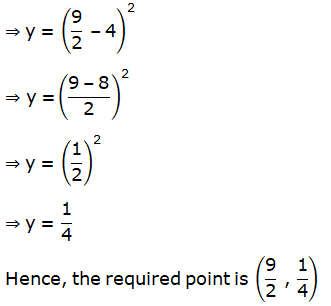Chapter 15 MEAN VALUE THEOREMS
Class 12th Maths R D Sharma Solution
Access Answers to RD Sharma Solutions For Class 12 Maths Chapter 15 – Mean Value Theorems
Exercise 15.1 Page No: 15.9
Exercise 15.1 Page No: 15.9
1. Discuss the applicability of Rolle’s Theorem for the following functions on the indicated intervals:

Solution:
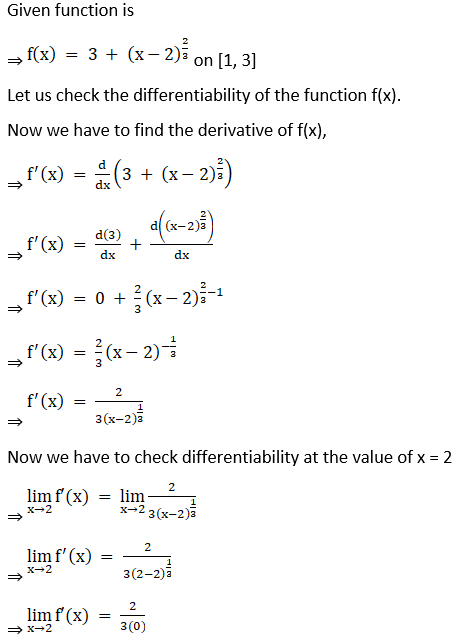

(ii) f (x) = [x] for -1 ≤ x ≤ 1, where [x] denotes the greatest integer not exceeding x
Solution:
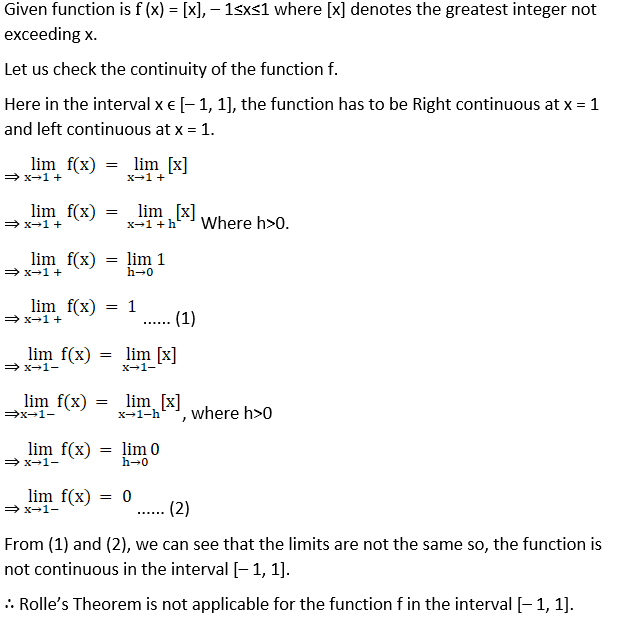

Solution:
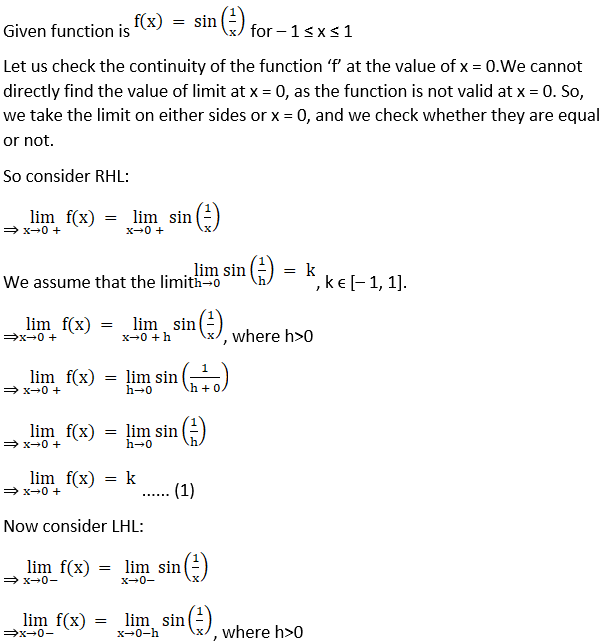

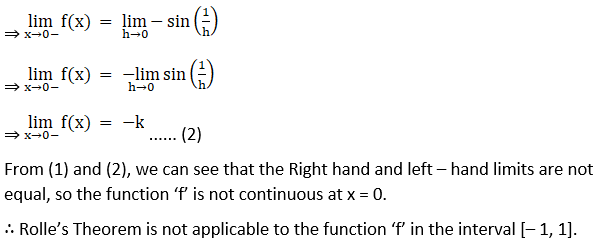
(iv) f (x) = 2x2 – 5x + 3 on [1, 3]
Solution:
Given function is f (x) = 2x2 – 5x + 3 on [1, 3]
Since given function f is a polynomial. So, it is continuous and differentiable everywhere.
Now, we find the values of function at the extreme values.
⇒ f (1) = 2(1)2–5(1) + 3
⇒ f (1) = 2 – 5 + 3
⇒ f (1) = 0…… (1)
⇒ f (3) = 2(3)2–5(3) + 3
⇒ f (3) = 2(9)–15 + 3
⇒ f (3) = 18 – 12
⇒ f (3) = 6…… (2)
From (1) and (2), we can say that, f (1) ≠ f (3)
∴ Rolle’s Theorem is not applicable for the function f in interval [1, 3].
(v) f (x) = x2/3 on [-1, 1]
Solution:
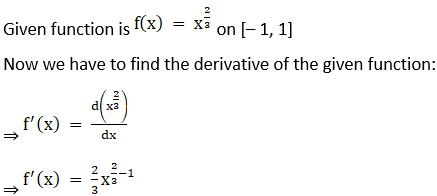
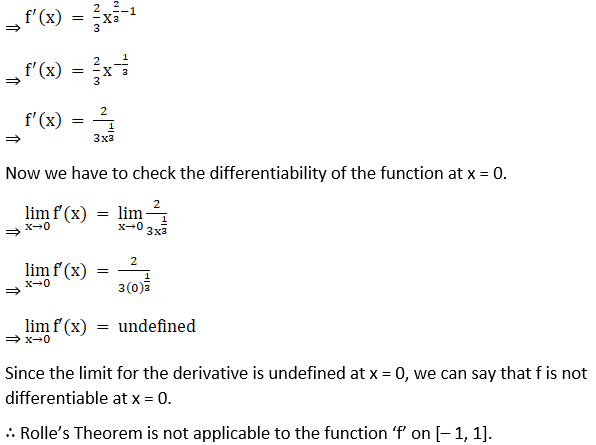

Solution:
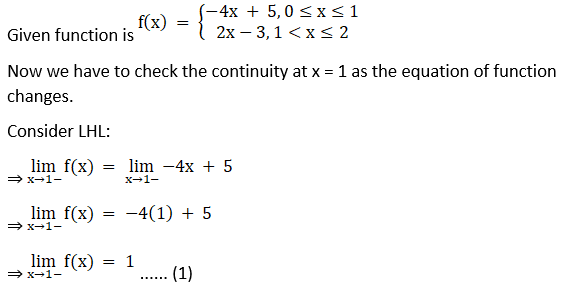
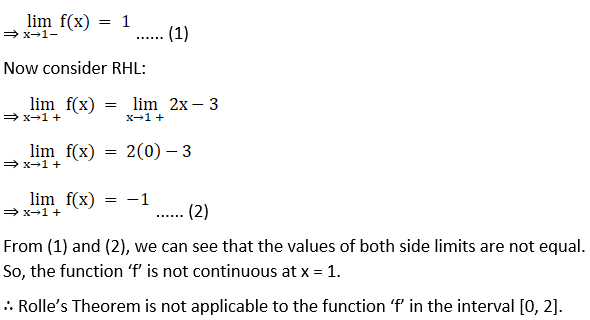
2. Verify the Rolle’s Theorem for each of the following functions on the indicated intervals:
(i) f (x) = x2 – 8x + 12 on [2, 6]
Solution:
Given function is f (x) = x2 – 8x + 12 on [2, 6]
Since, given function f is a polynomial it is continuous and differentiable everywhere i.e., on R.
Let us find the values at extremes:
⇒ f (2) = 22 – 8(2) + 12
⇒ f (2) = 4 – 16 + 12
⇒ f (2) = 0
⇒ f (6) = 62 – 8(6) + 12
⇒ f (6) = 36 – 48 + 12
⇒ f (6) = 0
∴ f (2) = f(6), Rolle’s theorem applicable for function f on [2,6].
Now we have to find the derivative of f(x)
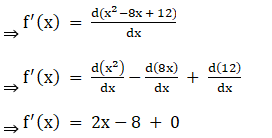
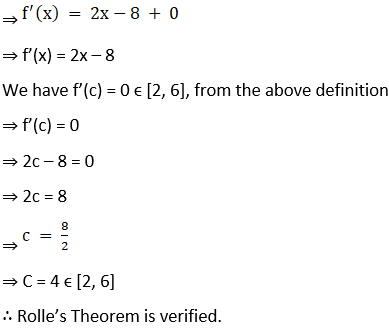
(ii) f(x) = x2 – 4x + 3 on [1, 3]
Solution:
Given function is f (x) = x2 – 4x + 3 on [1, 3]
Since, given function f is a polynomial it is continuous and differentiable everywhere i.e., on R. Let us find the values at extremes:
⇒ f (1) = 12 – 4(1) + 3
⇒ f (1) = 1 – 4 + 3
⇒ f (1) = 0
⇒ f (3) = 32 – 4(3) + 3
⇒ f (3) = 9 – 12 + 3
⇒ f (3) = 0
∴ f (1) = f(3), Rolle’s theorem applicable for function ‘f’ on [1,3].
Let’s find the derivative of f(x)
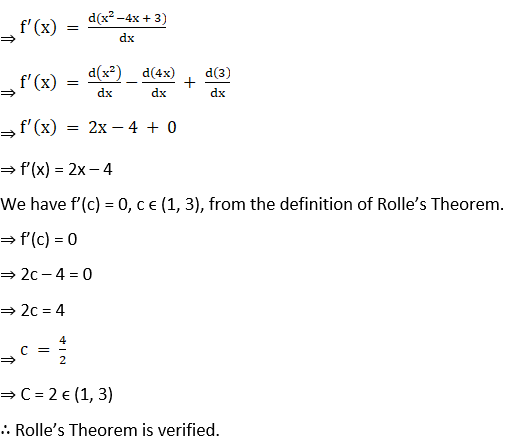
⇒ f’(x) = 2x – 4
We have f’(c) = 0, c ϵ (1, 3), from the definition of Rolle’s Theorem.
⇒ f’(c) = 0
⇒ 2c – 4 = 0
⇒ 2c = 4
⇒ c = 4/2
⇒ C = 2 ϵ (1, 3)
∴ Rolle’s Theorem is verified.
(iii) f (x) = (x – 1) (x – 2)2 on [1, 2]
Solution:
Given function is f (x) = (x – 1) (x – 2)2 on [1, 2]
Since, given function f is a polynomial it is continuous and differentiable everywhere that is on R.
Let us find the values at extremes:
⇒ f (1) = (1 – 1) (1 – 2)2
⇒ f (1) = 0(1)2
⇒ f (1) = 0
⇒ f (2) = (2 – 1)(2 – 2)2
⇒ f (2) = 02
⇒ f (2) = 0
∴ f (1) = f (2), Rolle’s Theorem applicable for function ‘f’ on [1, 2].
Let’s find the derivative of f(x)
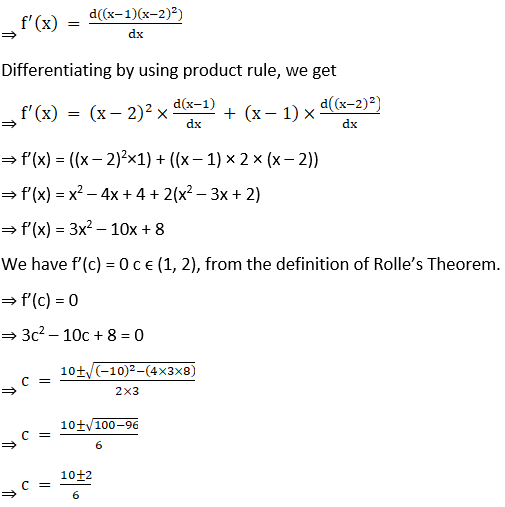
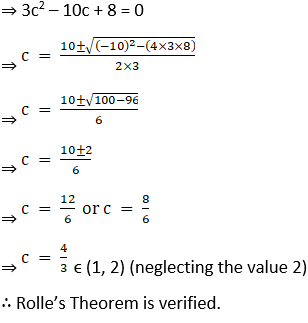
(iv) f (x) = x (x – 1)2 on [0, 1]
Solution:
Given function is f (x) = x(x – 1)2 on [0, 1]
Since, given function f is a polynomial it is continuous and differentiable everywhere that is, on R.
Let us find the values at extremes
⇒ f (0) = 0 (0 – 1)2
⇒ f (0) = 0
⇒ f (1) = 1 (1 – 1)2
⇒ f (1) = 02
⇒ f (1) = 0
∴ f (0) = f (1), Rolle’s theorem applicable for function ‘f’ on [0,1].
Let’s find the derivative of f(x)
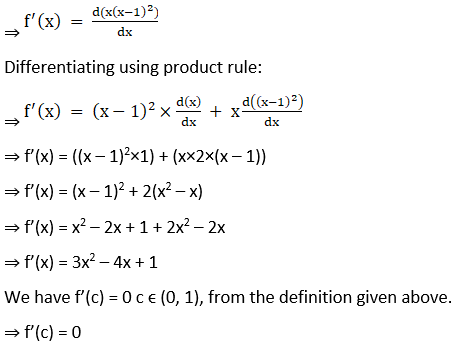
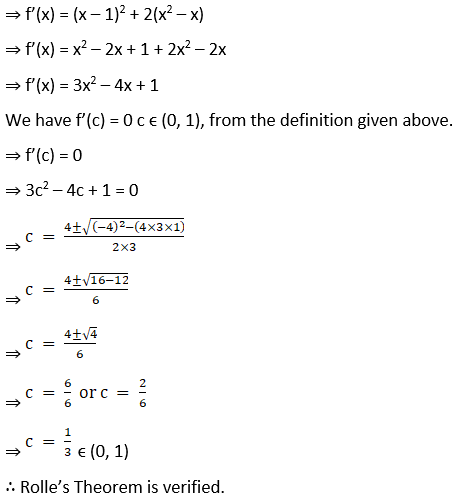
(v) f (x) = (x2 – 1) (x – 2) on [-1, 2]
Solution:
Given function is f (x) = (x2 – 1) (x – 2) on [– 1, 2]
Since, given function f is a polynomial it is continuous and differentiable everywhere that is on R.
Let us find the values at extremes:
⇒ f ( – 1) = (( – 1)2 – 1)( – 1 – 2)
⇒ f ( – 1) = (1 – 1)( – 3)
⇒ f ( – 1) = (0)( – 3)
⇒ f ( – 1) = 0
⇒ f (2) = (22 – 1)(2 – 2)
⇒ f (2) = (4 – 1)(0)
⇒ f (2) = 0
∴ f (– 1) = f (2), Rolle’s theorem applicable for function f on [ – 1,2].
Let’s find the derivative of f(x)
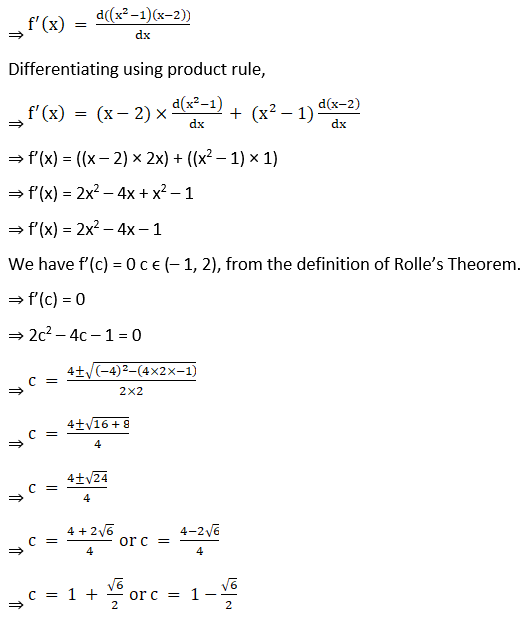
f’(x) = 3x2 – 4x – 1
We have f’(c) = 0 c ∈ (-1, 2), from the definition of Rolle’s Theorem
f'(c) = 0
3c2 – 4c – 1 = 0
c = 4 ± √[(-4)2 – (4 x 3 x -1)]/ (2 x 3) [Using the Quadratic Formula]
c = 4 ± √[16 + 12]/ 6
c = (4 ± √28)/ 6
c = (4 ± 2√7)/ 6
c = (2 ±√7)/ 3 = 1.5 ± √7/3
c = 1.5 + √7/3 or 1.5 – √7/3
So,
c = 1.5 – √7/3 since c ∈ (-1, 2)
∴ Rolle’s Theorem is verified.
(vi) f (x) = x (x – 4)2 on [0, 4]
Solution:
Given function is f (x) = x (x – 4)2 on [0, 4]
Since, given function f is a polynomial it is continuous and differentiable everywhere i.e., on R.
Let us find the values at extremes:
⇒ f (0) = 0(0 – 4)2
⇒ f (0) = 0
⇒ f (4) = 4(4 – 4)2
⇒ f (4) = 4(0)2
⇒ f (4) = 0
∴ f (0) = f (4), Rolle’s theorem applicable for function ‘f’ on [0,4].
Let’s find the derivative of f(x):
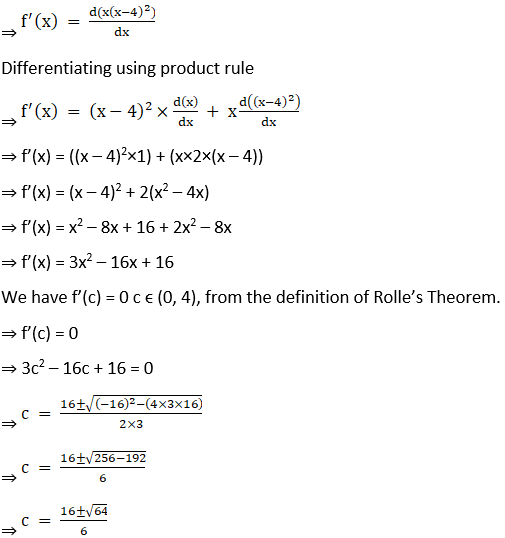
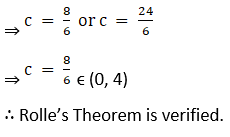
(vii) f (x) = x (x – 2)2 on [0, 2]
Solution:
Given function is f (x) = x (x – 2)2 on [0, 2]
Since, given function f is a polynomial it is continuous and differentiable everywhere that is on R.
Let us find the values at extremes:
⇒ f (0) = 0(0 – 2)2
⇒ f (0) = 0
⇒ f (2) = 2(2 – 2)2
⇒ f (2) = 2(0)2
⇒ f (2) = 0
f (0) = f(2), Rolle’s theorem applicable for function f on [0,2].
Let’s find the derivative of f(x)
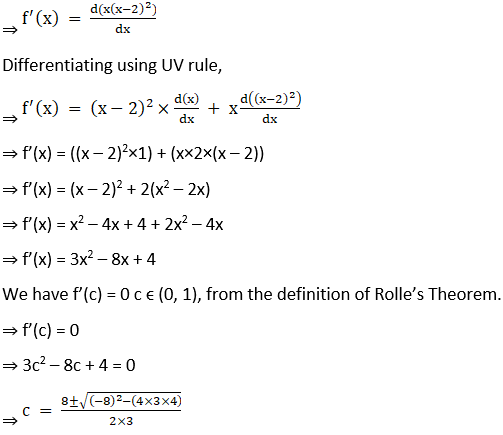
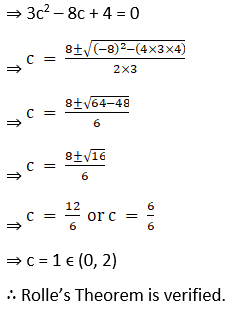
c = 12/6 or 4/6
c = 2 or 2/3
So,
c = 2/3 since c ∈ (0, 2)
∴ Rolle’s Theorem is verified.
(viii) f (x) = x2 + 5x + 6 on [-3, -2]
Solution:
Given function is f (x) = x2 + 5x + 6 on [– 3, – 2]
Since, given function f is a polynomial it is continuous and differentiable everywhere i.e., on R. Let us find the values at extremes:
⇒ f ( – 3) = ( – 3)2 + 5( – 3) + 6
⇒ f ( – 3) = 9 – 15 + 6
⇒ f ( – 3) = 0
⇒ f ( – 2) = ( – 2)2 + 5( – 2) + 6
⇒ f ( – 2) = 4 – 10 + 6
⇒ f ( – 2) = 0
∴ f (– 3) = f( – 2), Rolle’s theorem applicable for function f on [ – 3, – 2].
Let’s find the derivative of f(x):
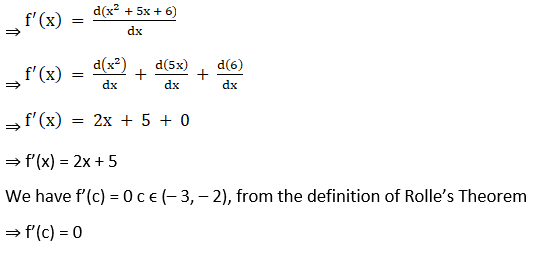
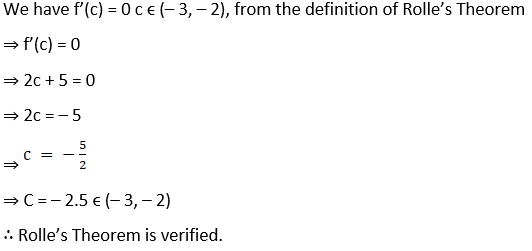
3. Verify the Rolle’s Theorem for each of the following functions on the indicated intervals:
(i) f (x) = cos 2 (x – π/4) on [0, π/2]
Solution:
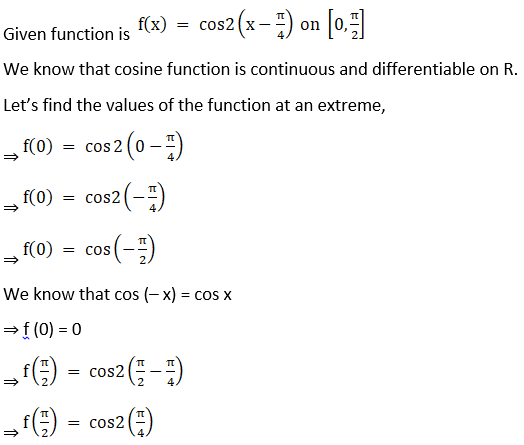
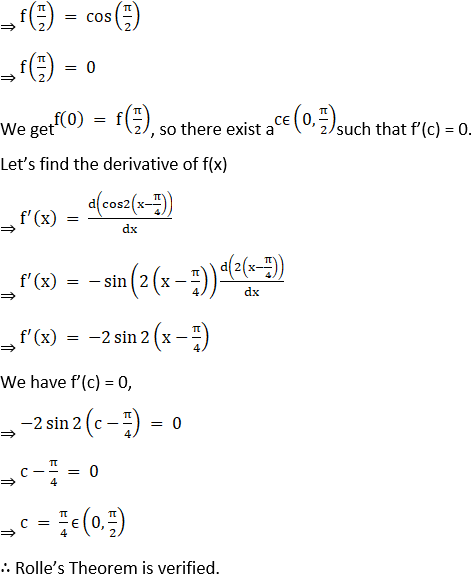
(ii) f (x) = sin 2x on [0, π/2]
Solution:
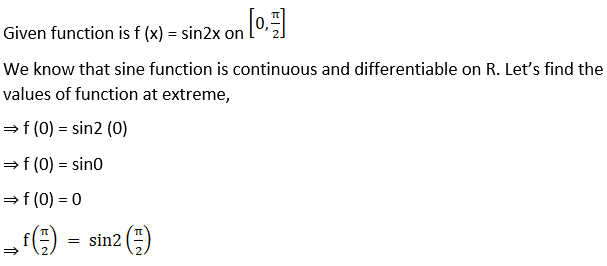
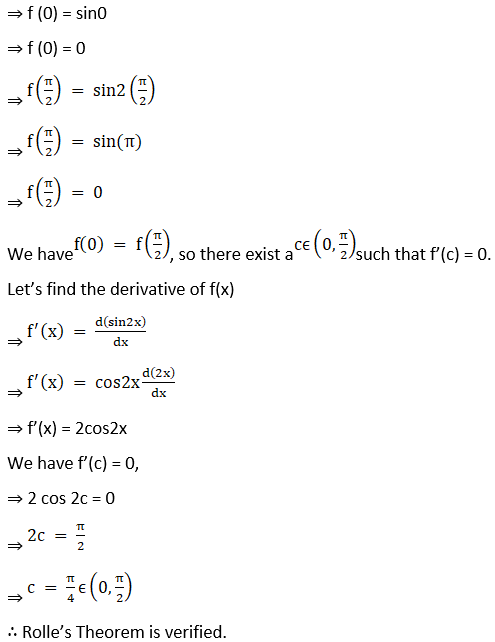
(iii) f (x) = cos 2x on [-π/4, π/4]
Solution:
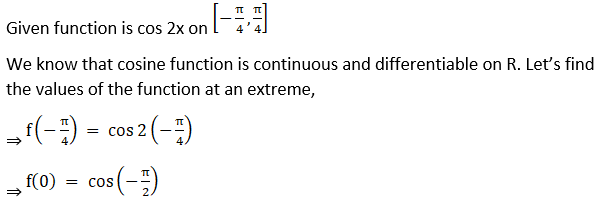
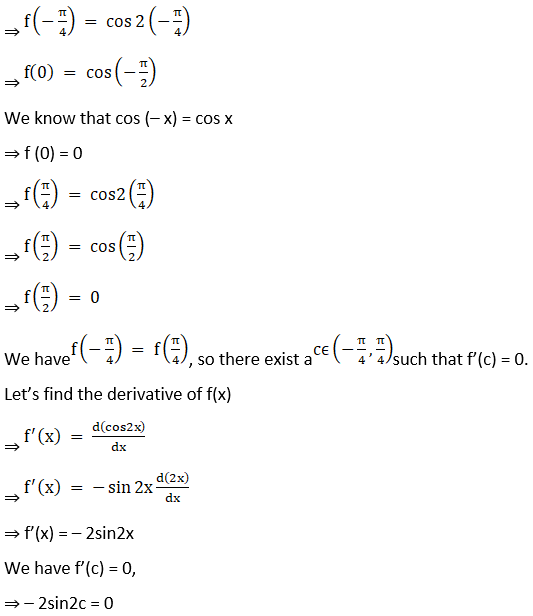
sin 2c = 0
⇒ 2c = 0
So,
c = 0 as c ∈ (-π/4, π/4)
∴ Rolle’s Theorem is verified.
(iv) f (x) = ex sin x on [0, π]
Solution:
Given function is f (x) = ex sin x on [0, π]
We know that exponential and sine functions are continuous and differentiable on R. Let’s find the values of the function at an extreme,
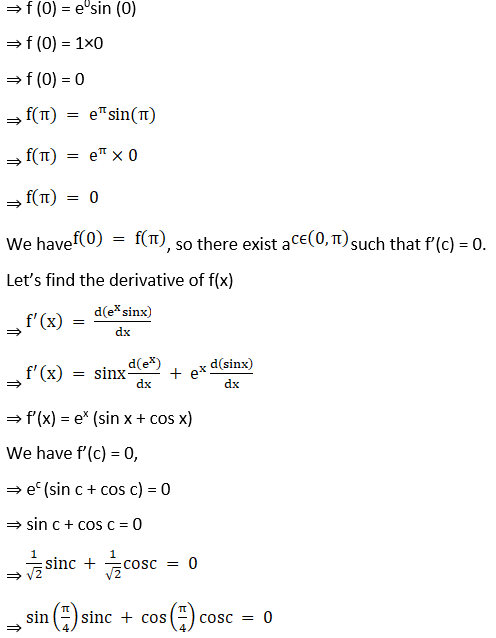
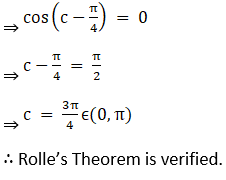
(v) f (x) = ex cos x on [-π/2, π/2]
Solution:
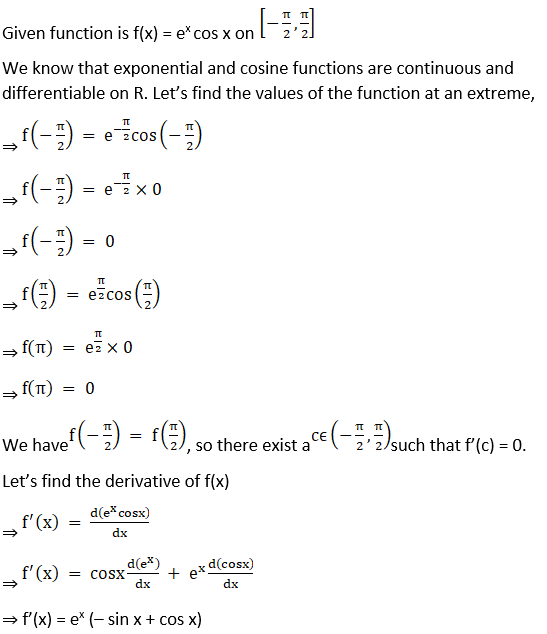
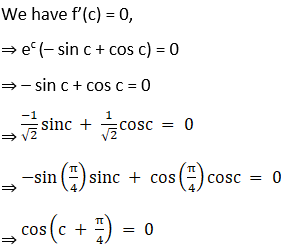
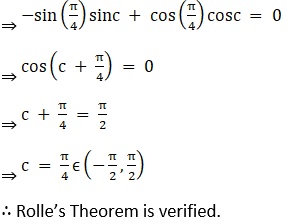
(vi) f (x) = cos 2x on [0, π]
Solution:
Given function is f (x) = cos 2x on [0, π]
We know that cosine function is continuous and differentiable on R. Let’s find the values of function at extreme,
⇒ f (0) = cos2(0)
⇒ f (0) = cos(0)
⇒ f (0) = 1
⇒ f (π) = cos2( )
)
⇒ f (π) = cos(2 π)
⇒ f (π) = 1
We have f (0) = f (π), so there exist a c belongs to (0, π) such that f’(c) = 0.
Let’s find the derivative of f(x)
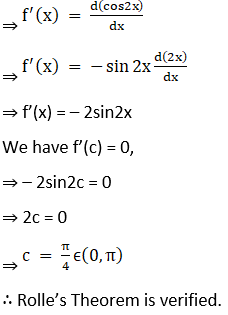
sin 2c = 0
So, 2c = 0 or π
c = 0 or π/2
But,
c = π/2 as c ∈ (0, π)
Hence, Rolle’s Theorem is verified.

Solution:
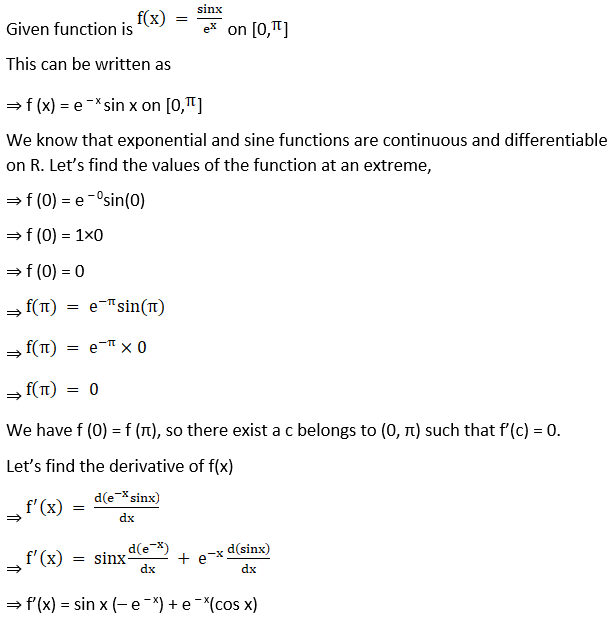
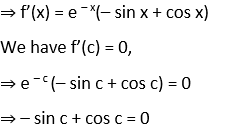
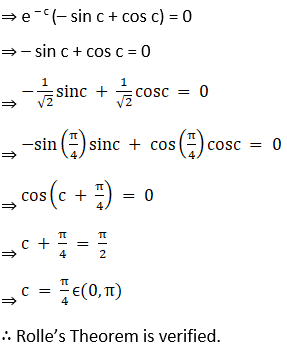
(viii) f (x) = sin 3x on [0, π]
Solution:
Given function is f (x) = sin3x on [0, π]
We know that sine function is continuous and differentiable on R. Let’s find the values of function at extreme,
⇒ f (0) = sin3(0)
⇒ f (0) = sin0
⇒ f (0) = 0
⇒ f (π) = sin3(π)
⇒ f (π) = sin(3 π)
⇒ f (π) = 0
We have f (0) = f (π), so there exist a c belongs to (0, π) such that f’(c) = 0.
Let’s find the derivative of f(x)
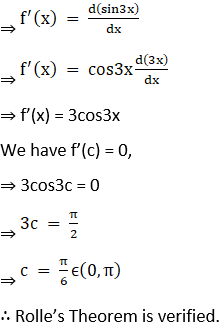
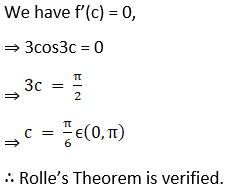

Solution:
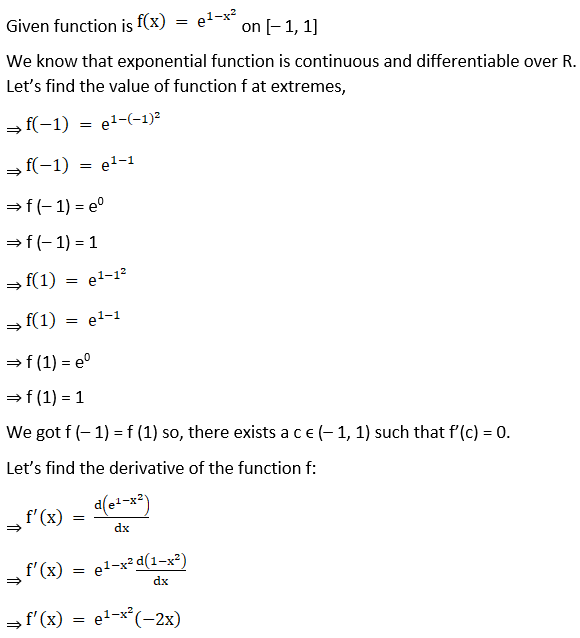
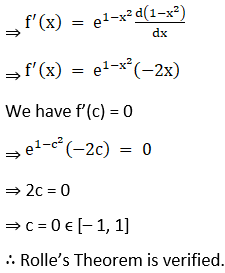
(x) f (x) = log (x2 + 2) – log 3 on [-1, 1]
Solution:
Given function is f (x) = log(x2 + 2) – log3 on [– 1, 1]
We know that logarithmic function is continuous and differentiable in its own domain. We check the values of the function at the extreme,
⇒ f (– 1) = log((– 1)2 + 2) – log 3
⇒ f (– 1) = log (1 + 2) – log 3
⇒ f (– 1) = log 3 – log 3
⇒ f ( – 1) = 0
⇒ f (1) = log (12 + 2) – log 3
⇒ f (1) = log (1 + 2) – log 3
⇒ f (1) = log 3 – log 3
⇒ f (1) = 0
We have got f (– 1) = f (1). So, there exists a c such that c ϵ (– 1, 1) such that f’(c) = 0.
Let’s find the derivative of the function f,
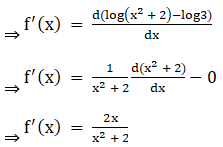
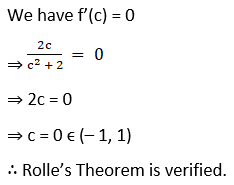
(xi) f (x) = sin x + cos x on [0, π/2]
Solution:
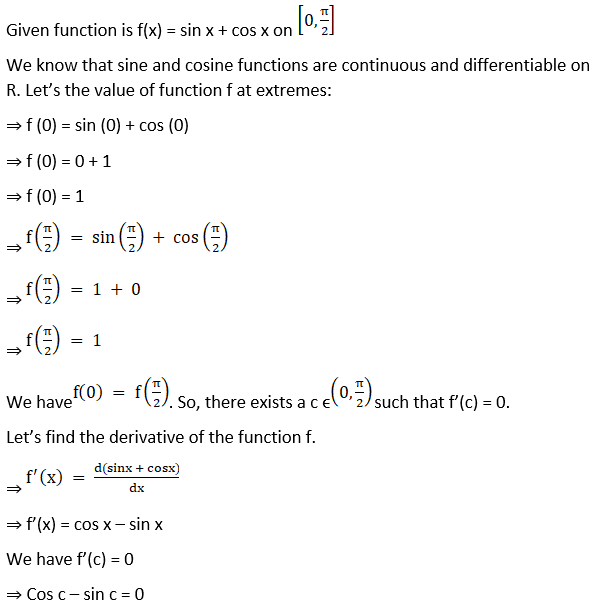
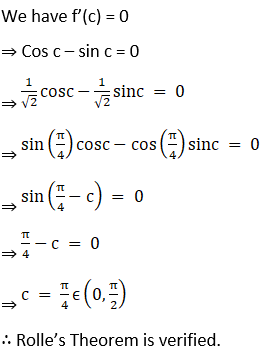
(xii) f (x) = 2 sin x + sin 2x on [0, π]
Solution:
Given function is f (x) = 2sinx + sin2x on [0, π]
We know that sine function continuous and differentiable over R.
Let’s check the values of function f at the extremes
⇒ f (0) = 2sin(0) + sin2(0)
⇒ f (0) = 2(0) + 0
⇒ f (0) = 0
⇒ f (π) = 2sin(π) + sin2(π)
⇒ f (π) = 2(0) + 0
⇒ f (π) = 0
We have f (0) = f (π), so there exist a c belongs to (0, π) such that f’(c) = 0.
Let’s find the derivative of function f.
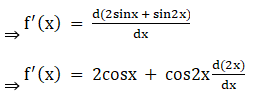
⇒ f’(x) = 2cosx + 2cos2x
⇒ f’(x) = 2cosx + 2(2cos2x – 1)
⇒ f’(x) = 4 cos2x + 2 cos x – 2
We have f’(c) = 0,
⇒ 4cos2c + 2 cos c – 2 = 0
⇒ 2cos2c + cos c – 1 = 0
⇒ 2cos2c + 2 cos c – cos c – 1 = 0
⇒ 2 cos c (cos c + 1) – 1 (cos c + 1) = 0
⇒ (2cos c – 1) (cos c + 1) = 0
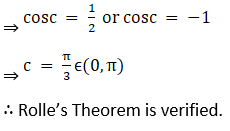

Solution:
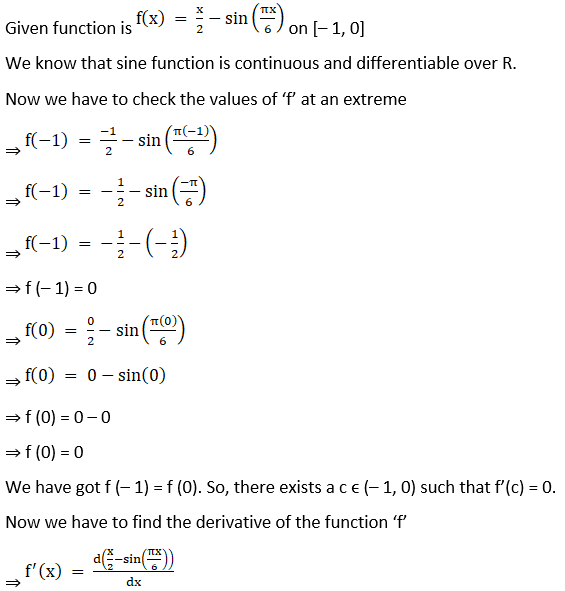
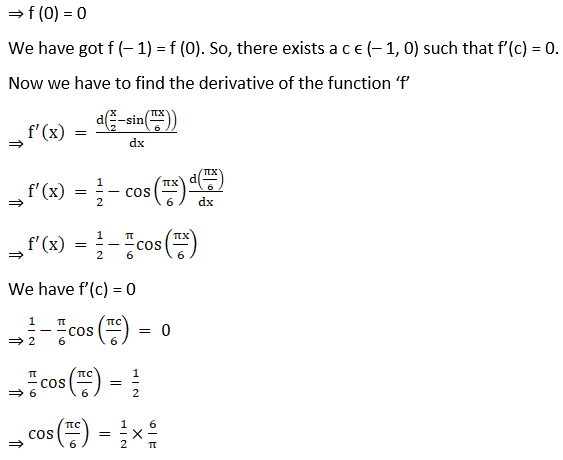
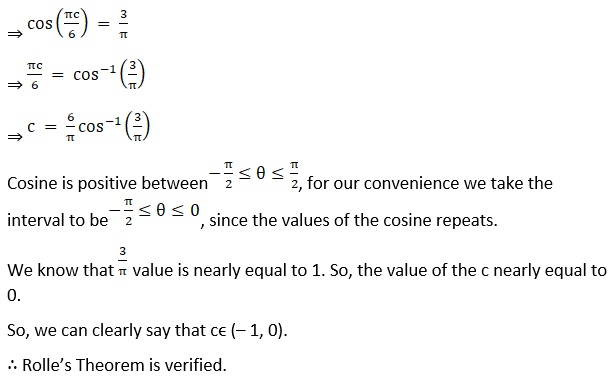

Solution:
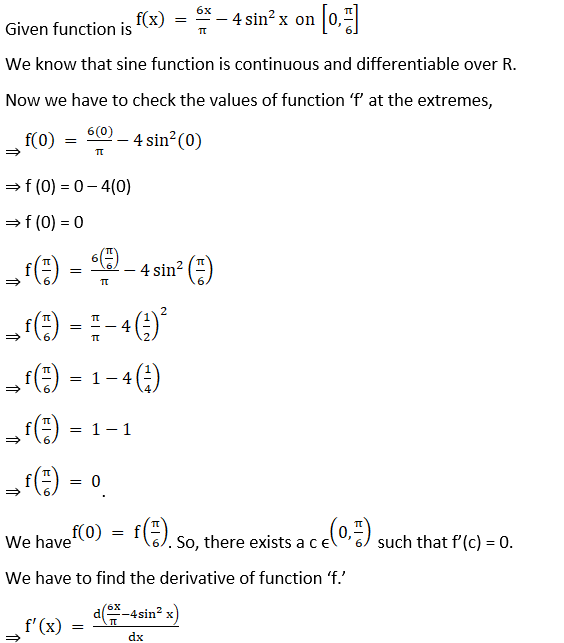

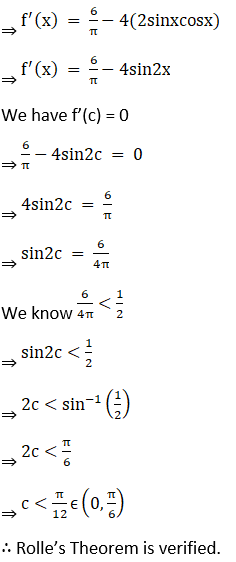
(xv) f (x) = 4sin x on [0, π]
Solution:
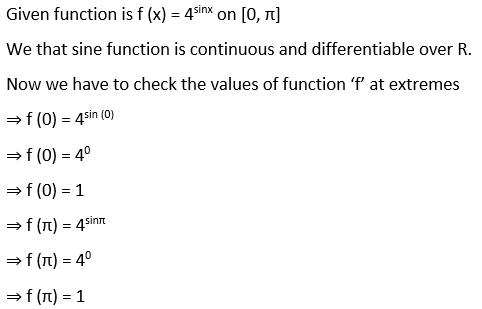
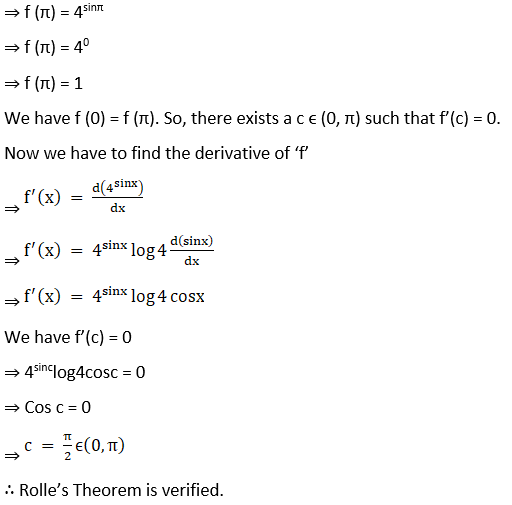
(xvi) f (x) = x2 – 5x + 4 on [0, π/6]
Solution:
Given function is f (x) = x2 – 5x + 4 on [1, 4]
Since, given function f is a polynomial it is continuous and differentiable everywhere i.e., on R.
Let us find the values at extremes
⇒ f (1) = 12 – 5(1) + 4
⇒ f (1) = 1 – 5 + 4
⇒ f (1) = 0
⇒ f (4) = 42 – 5(4) + 4
⇒ f (4) = 16 – 20 + 4
⇒ f (4) = 0
We have f (1) = f (4). So, there exists a c ϵ (1, 4) such that f’(c) = 0.
Let’s find the derivative of f(x):
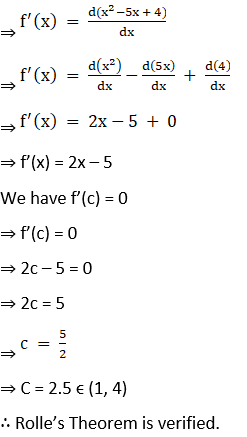
(xvii) f (x) = sin4 x + cos4 x on [0, π/2]
Solution:
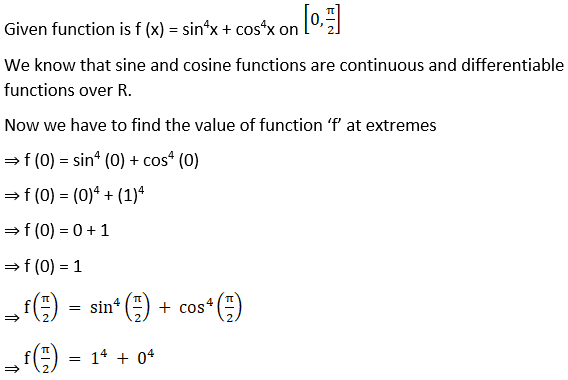
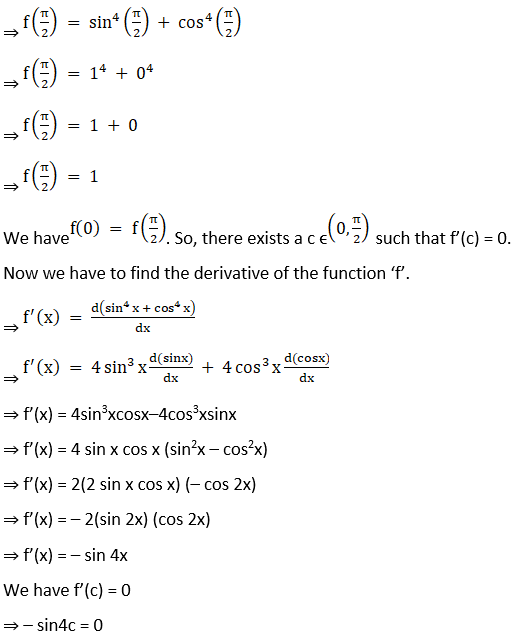
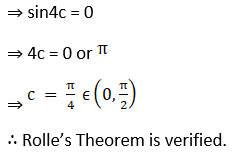
(xviii) f (x) = sin x – sin 2x on [0, π]
Solution:
Given function is f (x) = sin x – sin2x on [0, π]
We know that sine function is continuous and differentiable over R.
Now we have to check the values of the function ‘f’ at the extremes.
⇒ f (0) = sin (0)–sin 2(0)
⇒ f (0) = 0 – sin (0)
⇒ f (0) = 0
⇒ f (π) = sin(π) – sin2(π)
⇒ f (π) = 0 – sin(2π)
⇒ f (π) = 0
We have f (0) = f (π). So, there exists a c ϵ (0, π) such that f’(c) = 0.
Now we have to find the derivative of the function ‘f’
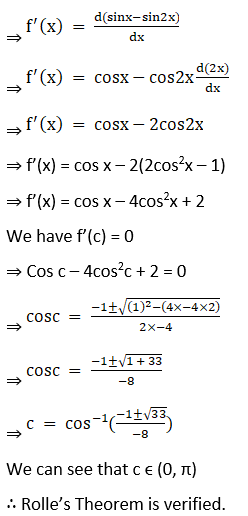
4. Using Rolle’s Theorem, find points on the curve y = 16 – x2, x ∈ [-1, 1], where tangent is parallel to x – axis.
Solution:
Given function is y = 16 – x2, x ϵ [– 1, 1]
We know that polynomial function is continuous and differentiable over R.
Let us check the values of ‘y’ at extremes
⇒ y (– 1) = 16 – (– 1)2
⇒ y (– 1) = 16 – 1
⇒ y (– 1) = 15
⇒ y (1) = 16 – (1)2
⇒ y (1) = 16 – 1
⇒ y (1) = 15
We have y (– 1) = y (1). So, there exists a c ϵ (– 1, 1) such that f’(c) = 0.
We know that for a curve g, the value of the slope of the tangent at a point r is given by g’(r).
Now we have to find the derivative of curve y
⇒
⇒ y’ = – 2x
We have y’(c) = 0
⇒ – 2c = 0
⇒ c = 0 ϵ (– 1, 1)
Value of y at x = 1 is
⇒ y = 16 – 02
⇒ y = 16
∴ The point at which the curve y has a tangent parallel to x – axis (since the slope of x – axis is 0) is (0, 16).
Exercise 15.2 Page No: 15.17
1. Verify Lagrange’s mean value theorem for the following functions on the indicated intervals. In each case find a point ‘c’ in the indicated interval as stated by the Lagrange’s mean value theorem:
(i) f (x) = x2 – 1 on [2, 3]
Solution:
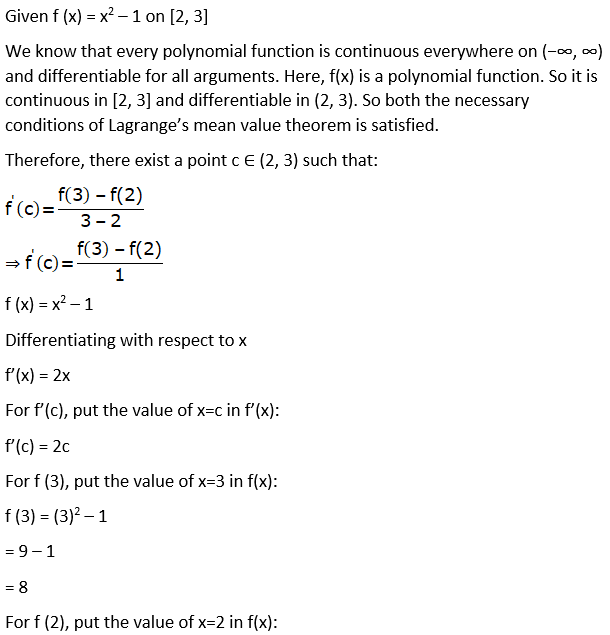
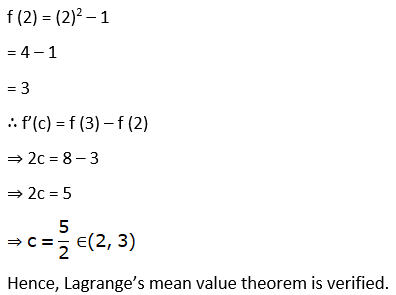
(ii) f (x) = x3 – 2x2 – x + 3 on [0, 1]
Solution:
Given f (x) = x3 – 2x2 – x + 3 on [0, 1]
Every polynomial function is continuous everywhere on (−∞, ∞) and differentiable for all arguments. Here, f(x) is a polynomial function. So it is continuous in [0, 1] and differentiable in (0, 1). So both the necessary conditions of Lagrange’s mean value theorem is satisfied.
Therefore, there exist a point c ∈ (0, 1) such that:
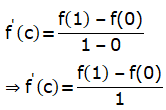
f (x) = x3 – 2x2 – x + 3
Differentiating with respect to x
f’(x) = 3x2 – 2(2x) – 1
= 3x2 – 4x – 1
For f’(c), put the value of x=c in f’(x)
f’(c)= 3c2 – 4c – 1
For f (1), put the value of x = 1 in f(x)
f (1)= (1)3 – 2(1)2 – (1) + 3
= 1 – 2 – 1 + 3
= 1
For f (0), put the value of x=0 in f(x)
f (0)= (0)3 – 2(0)2 – (0) + 3
= 0 – 0 – 0 + 3
= 3
∴ f’(c) = f(1) – f(0)
⇒ 3c2 – 4c – 1 = 1 – 3
⇒ 3c2 – 4c = 1 + 1 – 3
⇒ 3c2 – 4c = – 1
⇒ 3c2 – 4c + 1 = 0
⇒ 3c2 – 3c – c + 1 = 0
⇒ 3c(c – 1) – 1(c – 1) = 0
⇒ (3c – 1) (c – 1) = 0
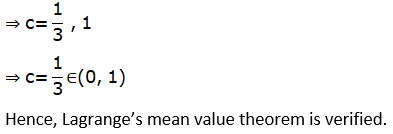
(iii) f (x) = x (x – 1) on [1, 2]
Solution:
Given f (x) = x (x – 1) on [1, 2]
= x2 – x
Every polynomial function is continuous everywhere on (−∞, ∞) and differentiable for all arguments. Here, f(x) is a polynomial function. So it is continuous in [1, 2] and differentiable in (1, 2). So both the necessary conditions of Lagrange’s mean value theorem is satisfied.
Therefore, there exist a point c ∈ (1, 2) such that:
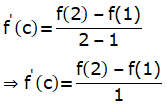
f (x) = x2 – x
Differentiating with respect to x
f’(x) = 2x – 1
For f’(c), put the value of x=c in f’(x):
f’(c)= 2c – 1
For f (2), put the value of x = 2 in f(x)
f (2) = (2)2 – 2
= 4 – 2
= 2
For f (1), put the value of x = 1 in f(x):
f (1)= (1)2 – 1
= 1 – 1
= 0
∴ f’(c) = f(2) – f(1)
⇒ 2c – 1 = 2 – 0
⇒ 2c = 2 + 1
⇒ 2c = 3

(iv) f (x) = x2 – 3x + 2 on [-1, 2]
Solution:
Given f (x) = x2 – 3x + 2 on [– 1, 2]
Every polynomial function is continuous everywhere on (−∞, ∞) and differentiable for all arguments. Here, f(x) is a polynomial function. So it is continuous in [– 1, 2] and differentiable in (– 1, 2). So both the necessary conditions of Lagrange’s mean value theorem is satisfied.
Therefore, there exist a point c ∈ (-1, 2) such that:
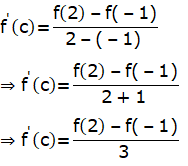
f (x) = x2 – 3x + 2
Differentiating with respect to x
f’(x) = 2x – 3
For f’(c), put the value of x = c in f’(x):
f’(c)= 2c – 3
For f (2), put the value of x = 2 in f(x)
f (2) = (2)2 – 3 (2) + 2
= 4 – 6 + 2
= 0
For f (– 1), put the value of x = – 1 in f(x):
f (– 1) = (– 1)2 – 3 (– 1) + 2
= 1 + 3 + 2
= 6
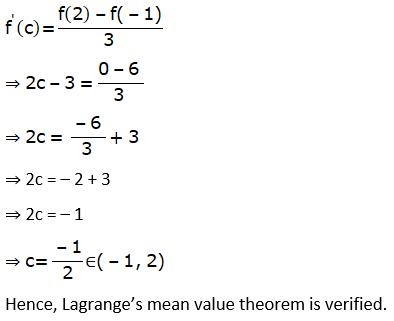
⇒ 2c = 1
⇒ c = ½ ∈ (-1, 2)
Hence, Lagrange’s mean value theorem is verified.
(v) f (x) = 2x2 – 3x + 1 on [1, 3]
Solution:
Given f (x) = 2x2 – 3x + 1 on [1, 3]
Every polynomial function is continuous everywhere on (−∞, ∞) and differentiable for all arguments. Here, f(x) is a polynomial function. So it is continuous in [1, 3] and differentiable in (1, 3). So both the necessary conditions of Lagrange’s mean value theorem is satisfied.
Therefore, there exist a point c ∈ (1, 3) such that:
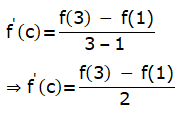
f (x) = 2x2 – 3x + 1
Differentiating with respect to x
f’(x) = 2(2x) – 3
= 4x – 3
For f’(c), put the value of x = c in f’(x):
f’(c)= 4c – 3
For f (3), put the value of x = 3 in f(x):
f (3) = 2 (3)2 – 3 (3) + 1
= 2 (9) – 9 + 1
= 18 – 8 = 10
For f (1), put the value of x = 1 in f(x):
f (1) = 2 (1)2 – 3 (1) + 1
= 2 (1) – 3 + 1
= 2 – 2 = 0
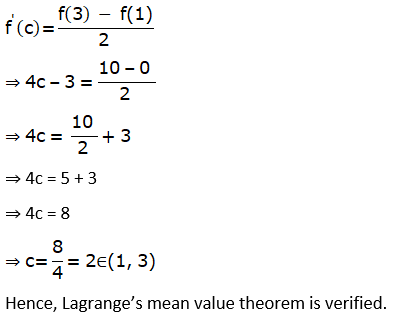
(vi) f (x) = x2 – 2x + 4 on [1, 5]
Solution:
Given f (x) = x2 – 2x + 4 on [1, 5]
Every polynomial function is continuous everywhere on (−∞, ∞) and differentiable for all arguments. Here, f(x) is a polynomial function. So it is continuous in [1, 5] and differentiable in (1, 5). So both the necessary conditions of Lagrange’s mean value theorem is satisfied.
Therefore, there exist a point c ∈ (1, 5) such that:
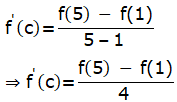
f (x) = x2 – 2x + 4
Differentiating with respect to x:
f’(x) = 2x – 2
For f’(c), put the value of x=c in f’(x):
f’(c)= 2c – 2
For f (5), put the value of x=5 in f(x):
f (5)= (5)2 – 2(5) + 4
= 25 – 10 + 4
= 19
For f (1), put the value of x = 1 in f(x)
f (1) = (1)2 – 2 (1) + 4
= 1 – 2 + 4
= 3
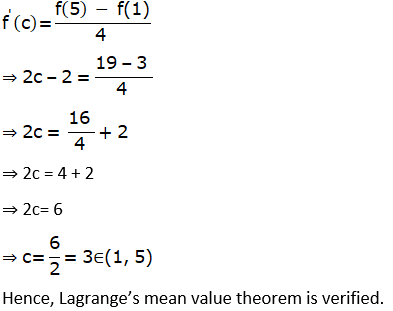
(vii) f (x) = 2x – x2 on [0, 1]
Solution:
Given f (x) = 2x – x2 on [0, 1]
Every polynomial function is continuous everywhere on (−∞, ∞) and differentiable for all arguments. Here, f(x) is a polynomial function. So it is continuous in [0, 1] and differentiable in (0, 1). So both the necessary conditions of Lagrange’s mean value theorem is satisfied.
Therefore, there exist a point c ∈ (0, 1) such that:

⇒ f’(c) = f(1) – f(0)
f (x) = 2x – x2
Differentiating with respect to x:
f’(x) = 2 – 2x
For f’(c), put the value of x = c in f’(x):
f’(c)= 2 – 2c
For f (1), put the value of x = 1 in f(x):
f (1)= 2(1) – (1)2
= 2 – 1
= 1
For f (0), put the value of x = 0 in f(x):
f (0) = 2(0) – (0)2
= 0 – 0
= 0
f’(c) = f(1) – f(0)
⇒ 2 – 2c = 1 – 0
⇒ – 2c = 1 – 2
⇒ – 2c = – 1

(viii) f (x) = (x – 1) (x – 2) (x – 3)
Solution:
Given f (x) = (x – 1) (x – 2) (x – 3) on [0, 4]
= (x2 – x – 2x + 2) (x – 3)
= (x2 – 3x + 2) (x – 3)
= x3 – 3x2 + 2x – 3x2 + 9x – 6
= x3 – 6x2 + 11x – 6 on [0, 4]
Every polynomial function is continuous everywhere on (−∞, ∞) and differentiable for all arguments. Here, f(x) is a polynomial function. So it is continuous in [0, 4] and differentiable in (0, 4). So both the necessary conditions of Lagrange’s mean value theorem is satisfied.
Therefore, there exist a point c ∈ (0, 4) such that:
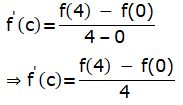
f (x) = x3 – 6x2 + 11x – 6
Differentiating with respect to x:
f’(x) = 3x2 – 6(2x) + 11
= 3x2 – 12x + 11
For f’(c), put the value of x = c in f’(x):
f’(c) = 3c2 – 12c + 11
For f (4), put the value of x = 4 in f(x):
f (4) = (4)3 – 6(4)2 + 11 (4) – 6
= 64 – 96 + 44 – 6
= 6
For f (0), put the value of x = 0 in f(x):
f (0) = (0)3 – 6 (0)2 + 11 (0) – 6
= 0 – 0 + 0 – 6
= – 6
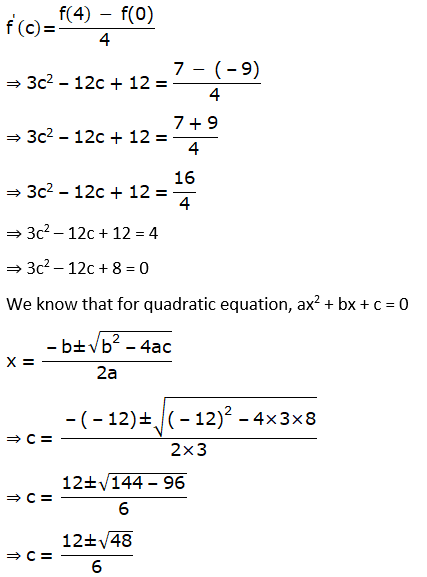
3c2 – 12c + 11 = [6 – (-6)]/ 4
3c2 – 12c + 11 = 12/4
3c2 – 12c + 11 = 3
3c2 – 12c + 8 = 0
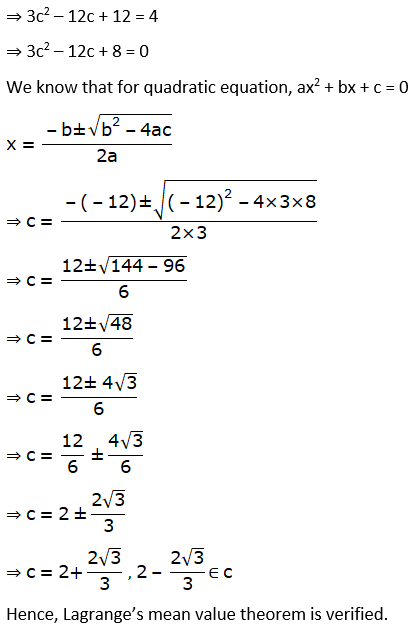

Solution:
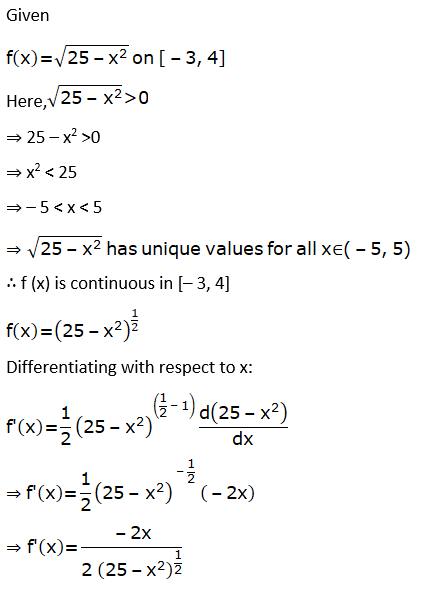
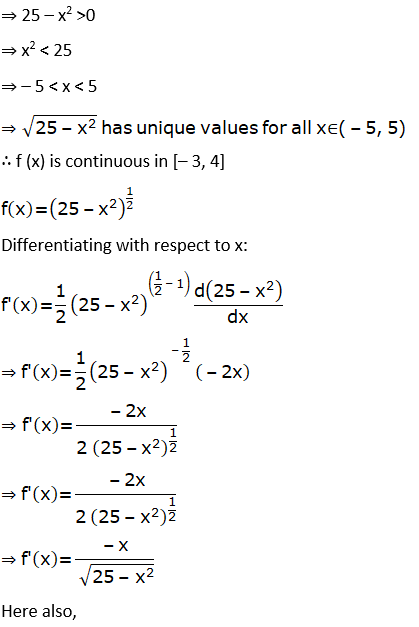
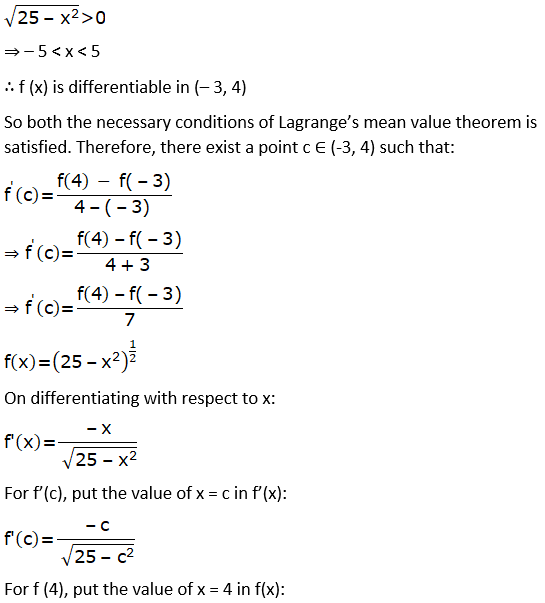
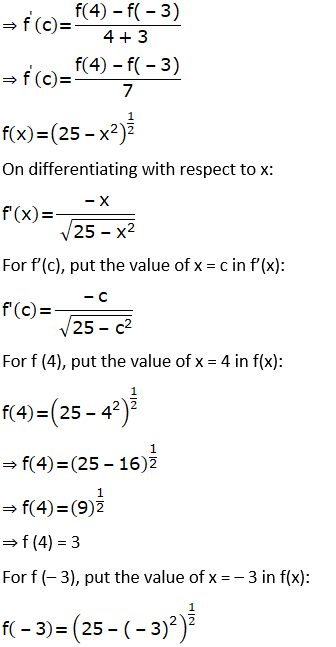
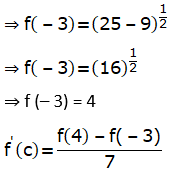
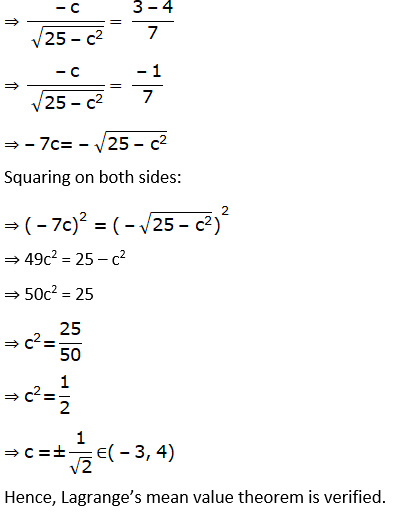
(x) f (x) = tan-1x on [0, 1]
Solution:
Given f (x) = tan – 1 x on [0, 1]
Tan – 1 x has unique value for all x between 0 and 1.
∴ f (x) is continuous in [0, 1]
f (x) = tan – 1 x
Differentiating with respect to x:

x2 always has value greater than 0.
⇒ 1 + x2 > 0
∴ f (x) is differentiable in (0, 1)
So both the necessary conditions of Lagrange’s mean value theorem is satisfied. Therefore, there exist a point c ∈ (0, 1) such that:
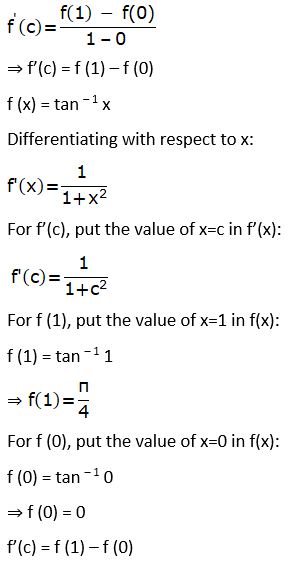
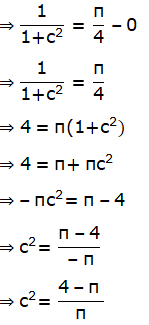
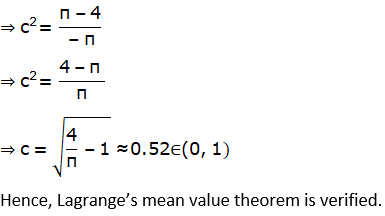

Solution:
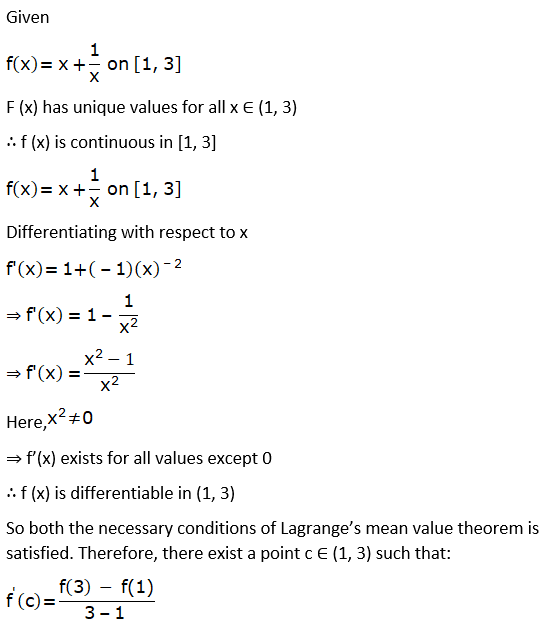
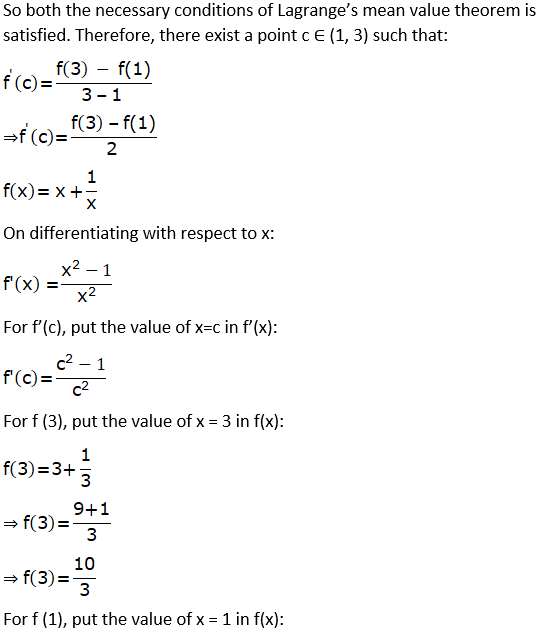
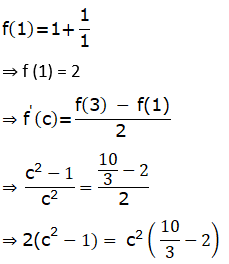
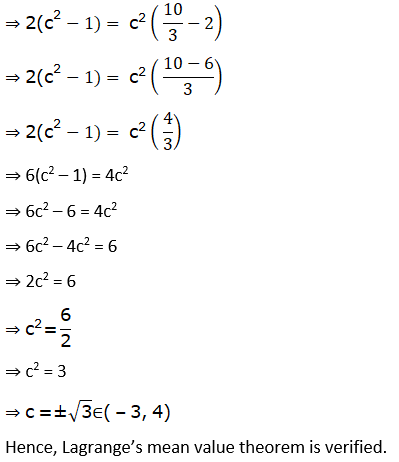
(xii) f (x) = x (x + 4)2 on [0, 4]
Solution:
Given f (x) = x (x + 4)2 on [0, 4]
= x [(x)2 + 2 (4) (x) + (4)2]
= x (x2 + 8x + 16)
= x3 + 8x2 + 16x on [0, 4]
Every polynomial function is continuous everywhere on (−∞, ∞) and differentiable for all arguments. Here, f(x) is a polynomial function. So it is continuous in [0, 4] and differentiable in (0, 4). So both the necessary conditions of Lagrange’s mean value theorem is satisfied. Therefore, there exist a point c ∈ (0, 4) such that:
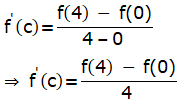
f (x) = x3 + 8x2 + 16x
Differentiating with respect to x:
f’(x) = 3x2 + 8(2x) + 16
= 3x2 + 16x + 16
For f’(c), put the value of x = c in f’(x):
f’(c)= 3c2 + 16c + 16
For f (4), put the value of x = 4 in f(x):
f (4)= (4)3 + 8(4)2 + 16(4)
= 64 + 128 + 64
= 256
For f (0), put the value of x = 0 in f(x):
f (0)= (0)3 + 8(0)2 + 16(0)
= 0 + 0 + 0
= 0
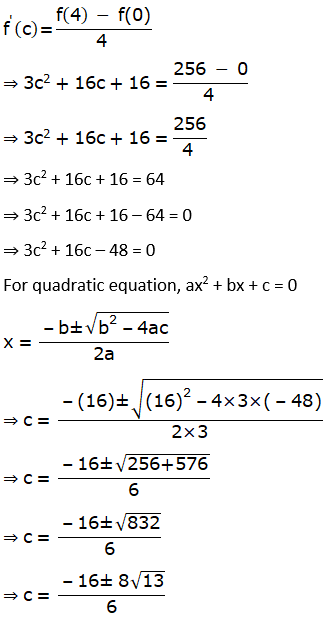
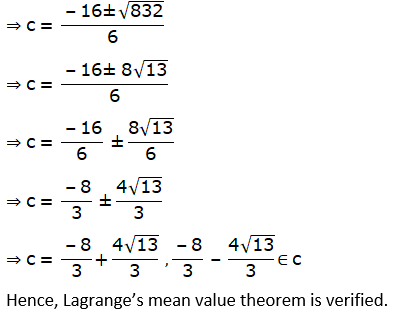

Solution:
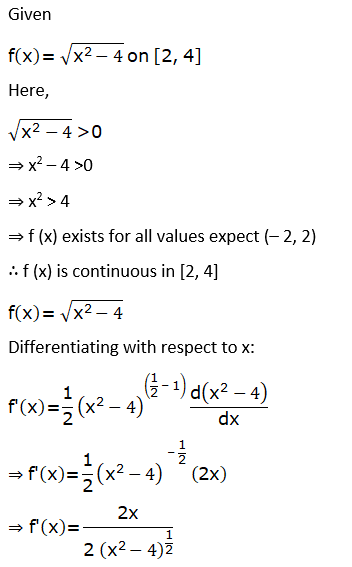
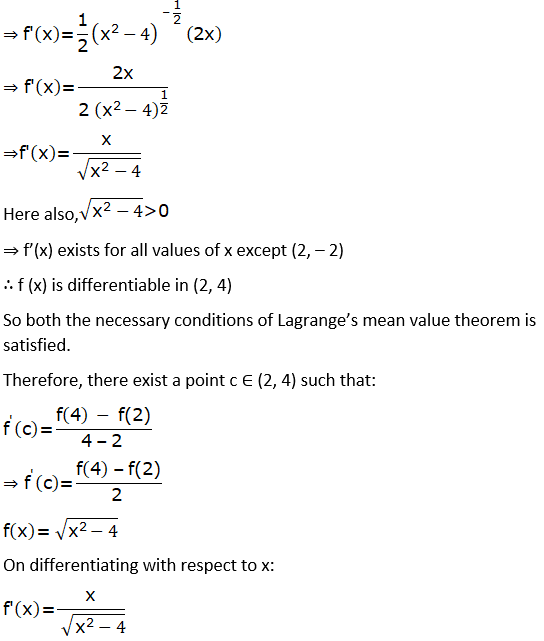
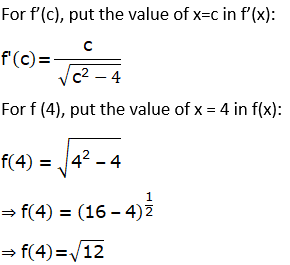
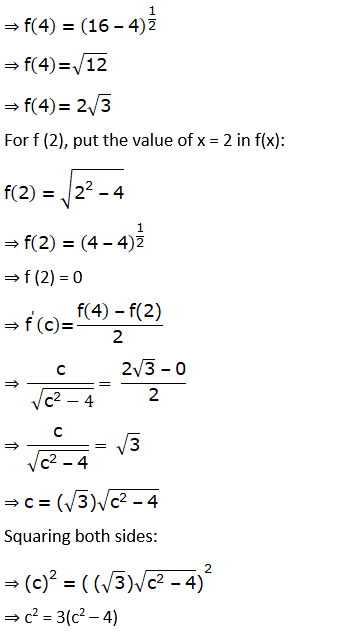
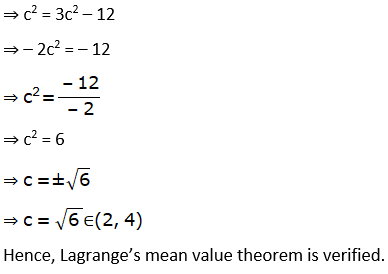

(xiv) f (x) = x2 + x – 1 on [0, 4]
Solution:
Given f (x) = x2 + x – 1 on [0, 4]
Every polynomial function is continuous everywhere on (−∞, ∞) and differentiable for all arguments. Here, f(x) is a polynomial function. So it is continuous in [0, 4] and differentiable in (0, 4). So both the necessary conditions of Lagrange’s mean value theorem is satisfied. Therefore, there exist a point c ∈ (0, 4) such that:
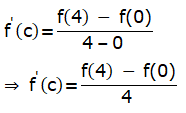
f (x) = x2 + x – 1
Differentiating with respect to x:
f’(x) = 2x + 1
For f’(c), put the value of x = c in f’(x):
f’(c) = 2c + 1
For f (4), put the value of x = 4 in f(x):
f (4)= (4)2 + 4 – 1
= 16 + 4 – 1
= 19
For f (0), put the value of x = 0 in f(x):
f (0) = (0)2 + 0 – 1
= 0 + 0 – 1
= – 1
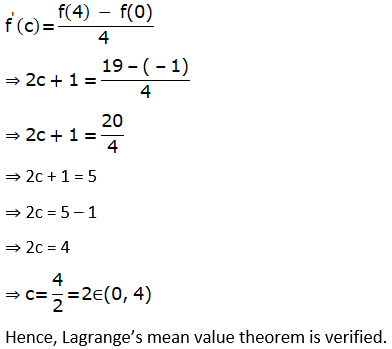
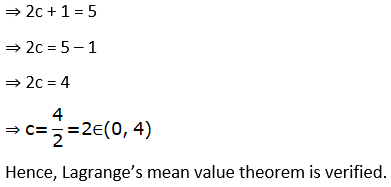
(xv) f (x) = sin x – sin 2x – x on [0, π]
Solution:
Given f (x) = sin x – sin 2x – x on [0, π]
Sin x and cos x functions are continuous everywhere on (−∞, ∞) and differentiable for all arguments. So both the necessary conditions of Lagrange’s mean value theorem is satisfied. Therefore, there exist a point c ∈ (0, π) such that:
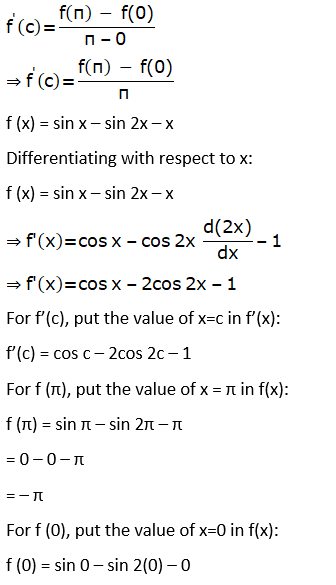
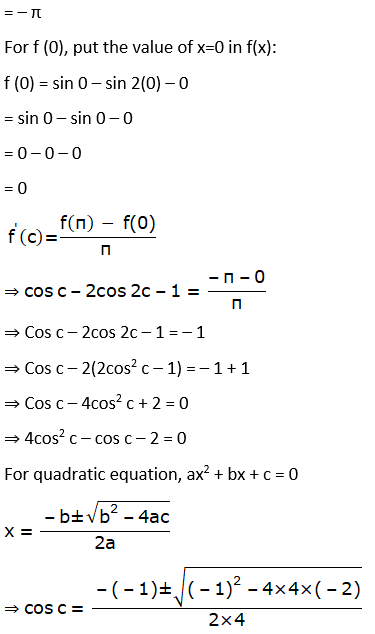
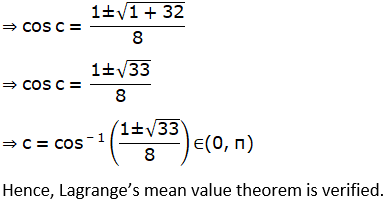
(xvi) f (x) = x3 – 5x2 – 3x on [1, 3]
Solution:
Given f (x) = x3 – 5x2 – 3x on [1, 3]
Every polynomial function is continuous everywhere on (−∞, ∞) and differentiable for all arguments. Here, f(x) is a polynomial function. So it is continuous in [1, 3] and differentiable in (1, 3). So both the necessary conditions of Lagrange’s mean value theorem is satisfied.
Therefore, there exist a point c ∈ (1, 3) such that:
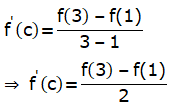
f (x) = x3 – 5x2 – 3x
Differentiating with respect to x:
f’(x) = 3x2 – 5(2x) – 3
= 3x2 – 10x – 3
For f’(c), put the value of x=c in f’(x):
f’(c)= 3c2 – 10c – 3
For f (3), put the value of x = 3 in f(x):
f (3)= (3)3 – 5(3)2 – 3(3)
= 27 – 45 – 9
= – 27
For f (1), put the value of x = 1 in f(x):
f (1)= (1)3 – 5 (1)2 – 3 (1)
= 1 – 5 – 3
= – 7
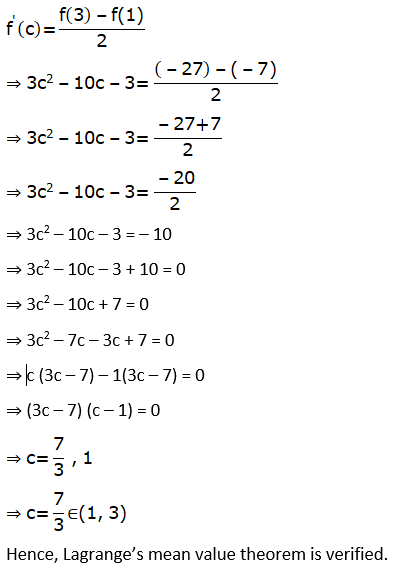
⇒ 3c2 – 10c – 3 = – 10
⇒ 3c2 – 10c – 3 + 10 = 0
⇒ 3c2 – 10c + 7 = 0
⇒ 3c2 – 7c – 3c + 7 = 0
⇒ c (3c – 7) – 1(3c – 7) = 0
⇒ (3c – 7) (c – 1) = 0
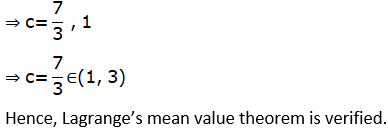
2. Discuss the applicability of Lagrange’s mean value theorem for the function f(x) = |x| on [– 1, 1].
Solution:
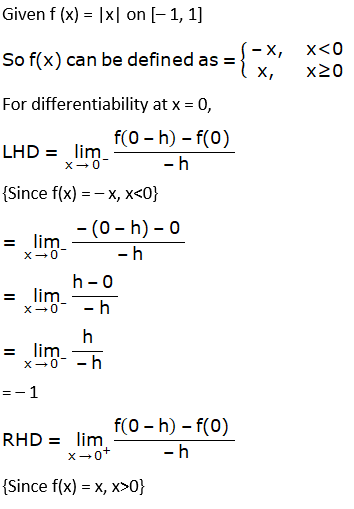
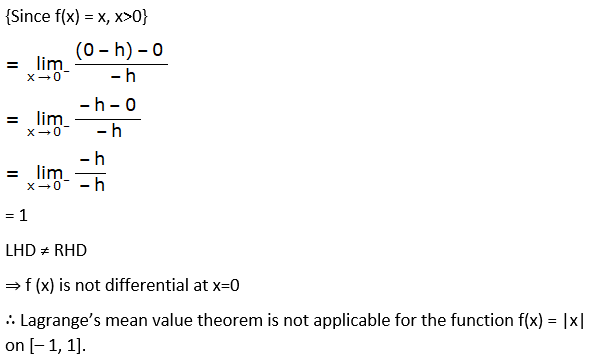
3. Show that the Lagrange’s mean value theorem is not applicable to the function f(x) = 1/x on [–1, 1].
Solution:
Given
Here, x ≠ 0
⇒ f (x) exists for all values of x except 0
⇒ f (x) is discontinuous at x=0
∴ f (x) is not continuous in [– 1, 1]
Hence the Lagrange’s mean value theorem is not applicable to the function f (x) = 1/x on [-1, 1]
4. Verify the hypothesis and conclusion of Lagrange’s mean value theorem for the function

Solution:
Given
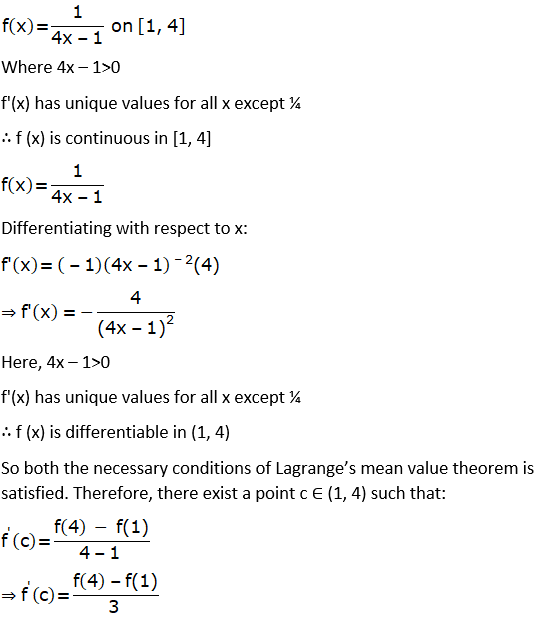
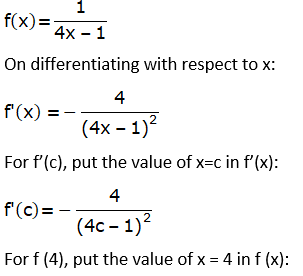
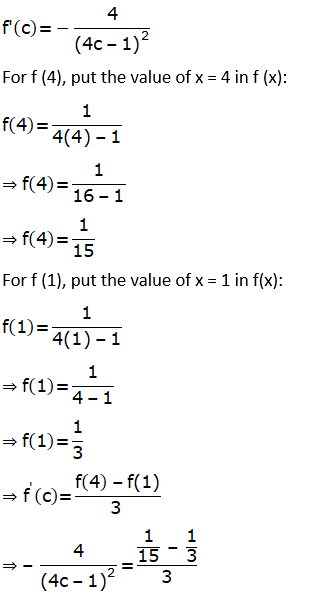
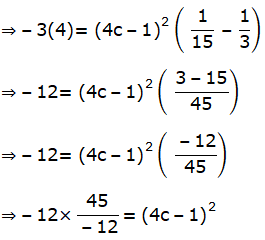
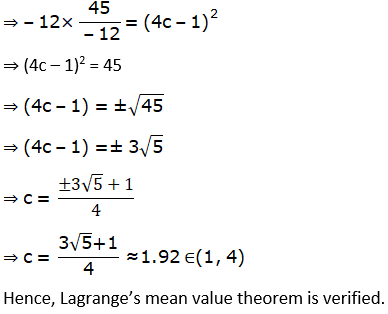
5. Find a point on the parabola y = (x – 4)2, where the tangent is parallel to the chord joining (4, 0) and (5, 1).
Solution:
Given f(x) = (x – 4)2 on [4, 5]
This interval [a, b] is obtained by x – coordinates of the points of the chord.
Every polynomial function is continuous everywhere on (−∞, ∞) and differentiable for all arguments. Here, f(x) is a polynomial function. So it is continuous in [4, 5] and differentiable in (4, 5). So both the necessary conditions of Lagrange’s mean value theorem is satisfied.
Therefore, there exist a point c ∈ (4, 5) such that:
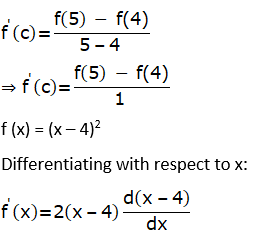
⇒ f’(x) = 2 (x – 4) (1)
⇒ f’(x) = 2 (x – 4)
For f’(c), put the value of x=c in f’(x):
f’(c) = 2 (c – 4)
For f (5), put the value of x=5 in f(x):
f (5) = (5 – 4)2
= (1)2
= 1
For f (4), put the value of x=4 in f(x):
f (4) = (4 – 4)2
= (0)2
= 0
f’(c) = f(5) – f(4)
⇒ 2(c – 4) = 1 – 0
⇒ 2c – 8 = 1
⇒ 2c = 1 + 8

We know that, the value of c obtained in Lagrange’s Mean value Theorem is nothing but the value of x – coordinate of the point of the contact of the tangent to the curve which is parallel to the chord joining the points (4, 0) and (5, 1).
Now, put this value of x in f(x) to obtain y:
y = (x – 4)2
